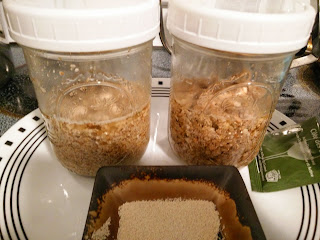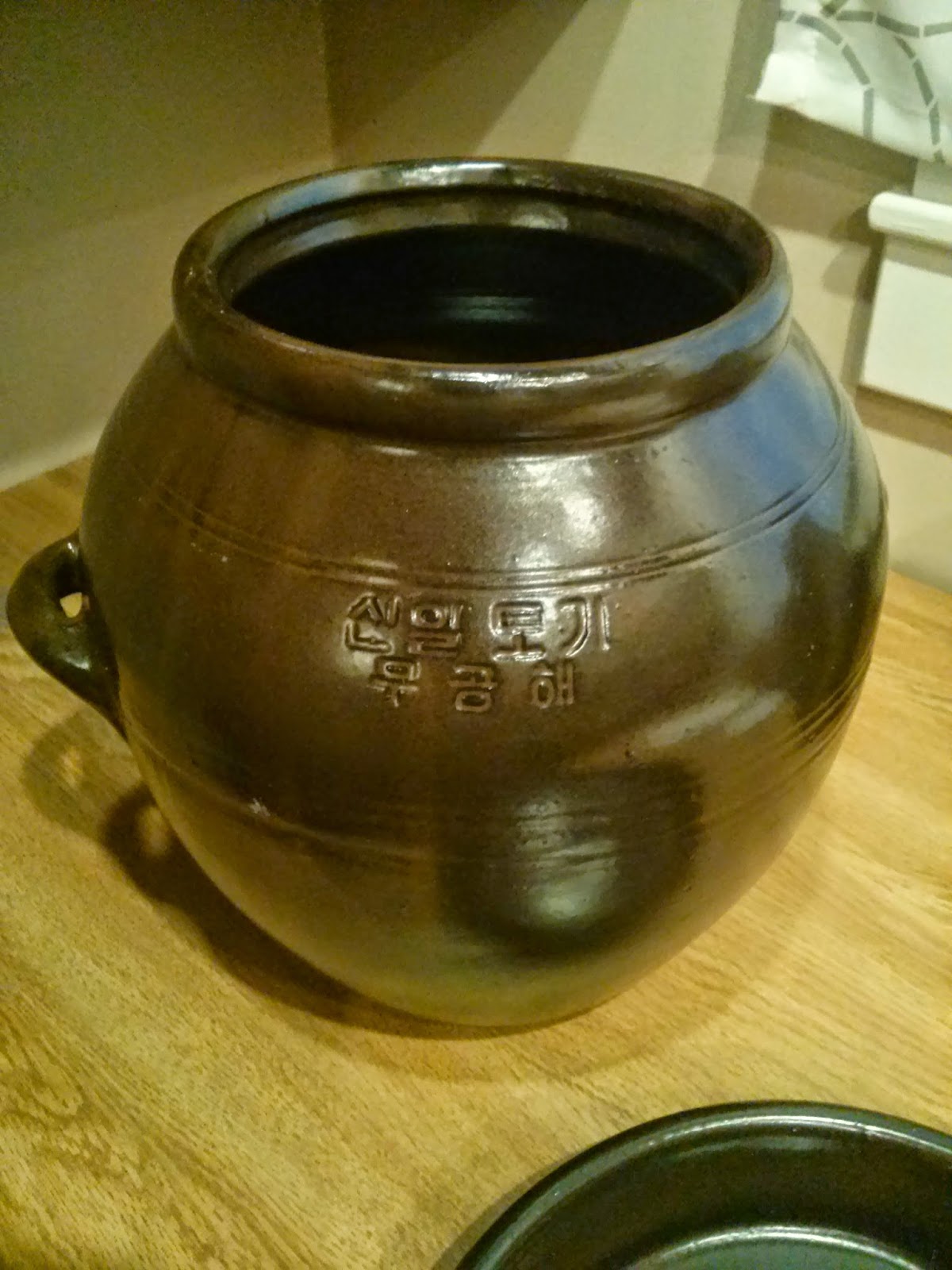50/50 White Rice/Brown Rice Makgeolli
Hey, it's been a while.
I've been busy with grad school courses, and we've been busy at home with holidays and preparing for my daughter's first birthday party. We are doing a few traditional Korean things, such as Dol-jabi, and having some Korean finger-foods on hand to celebrate. Naturally, I'll be making some makgeolli to go along with the food. There will be more on that in the coming weeks, but for now...
After the rice is steamed, place it on a rack to cool to room temperature (25 C). By the time the rice is cool, the nuruk should be thoroughly hydrated and ready for the yeast.
Stir the yeast into the sugok (hydrated nuruk) and let the yeast activate per the manufacturer's instruction. This time I used Red Star champagne yeast.
Mix the godu-bap and sugok+yeast into your fermentation vessel. Then, add the rest of the water and mix well.
Fermentation: Fermentation should take about a week to complete, with noticeable changes in the makgeolli each day. Make sure to stir the makgeolli daily with a sterilized spoon. You will know it is finished when all but a few grains of rice have sunk the bottom, and the liquid on top is clear with a yellowish tint.
Bottling: The bottles are prepped with a mixture or sweetener and water. I have been using a 1:1 ratio of makgeolli and water when bottling. I won't tell you how much sweetener I put in, because I suggest you sweeten to your liking.
I've been busy with grad school courses, and we've been busy at home with holidays and preparing for my daughter's first birthday party. We are doing a few traditional Korean things, such as Dol-jabi, and having some Korean finger-foods on hand to celebrate. Naturally, I'll be making some makgeolli to go along with the food. There will be more on that in the coming weeks, but for now...
 |
| Persimmon for additional autumn effect, not actually used in this makgeolli |
50/50 Makgeolli
(50% White Rice/50% Brown Rice)
This is a small, experimental brew in using 250 grams of white glutenous rice and 250 g of brown glutenous rice. Once diluted, it should yield about 2 liters of makgeolli, with some left over for...cooking?
Preparation: Clean and/or sterilize all equipment used for cooking rice and brewing makgeolli. This is a basic good practice for all food applications, especially when you are serving other people. Another bonus is that you will have a higher success rate since you're getting rid of detrimental microorganisms. This time I used One Step to sanitize the equipment.
Pre-Fermentation: The first step is to measure, wash, and soak the rice. I typically soak my rice overnight, but you may soak it less if you feel so inclined. I recommend a minimum of 3 hours soaking time for rice.
About an hour before the rice is done soaking, start to hydrate (read: soak) the nuruk. I typically put enough water to cover the dry nuruk, filling to about a knuckle over the nuruk's surface. Stir the water into the nuruk for even hydration. Hydrate the nuruk for 3 hours to make sugok.
When the rice is done soaking, place it in the steamer basket to rest for 30 minutes to an hour to let the excess water drip out. Then, fill the steamer reservoir with enough water to steam the rice for 30-45 minutes. I've been told the consistency of the rice should be somewhat transparent, but not completely cooked. It should squish between your fingers, but the rice grain should not break. Achieving this consistency may take some trial and error.
Lesson of the Day: Remember that white and brown rice have significantly different cooking times. As a result, steaming a mixed batch of rice to make godu-bap will probably result in either the brown rice being under-cooked, or the white rice being over-cooked. I recommend steaming them separately, if possible.
 |
| Some of the brown rice is not cooked enough. |
After the rice is steamed, place it on a rack to cool to room temperature (25 C). By the time the rice is cool, the nuruk should be thoroughly hydrated and ready for the yeast.
Stir the yeast into the sugok (hydrated nuruk) and let the yeast activate per the manufacturer's instruction. This time I used Red Star champagne yeast.
Mix the godu-bap and sugok+yeast into your fermentation vessel. Then, add the rest of the water and mix well.
Fermentation: Fermentation should take about a week to complete, with noticeable changes in the makgeolli each day. Make sure to stir the makgeolli daily with a sterilized spoon. You will know it is finished when all but a few grains of rice have sunk the bottom, and the liquid on top is clear with a yellowish tint.
 |
| This batch is very small compared to the hangari's volume, so it may look like the rice has not sunk, but it has. |
Bottling: The bottles are prepped with a mixture or sweetener and water. I have been using a 1:1 ratio of makgeolli and water when bottling. I won't tell you how much sweetener I put in, because I suggest you sweeten to your liking.
Tasting: I could tell that not all of the rice had fermented from the first sip. The taste was mild and not sweet, and the alcohol content was a bit weaker than usual. The undercooked brown rice had not fermented after all.
The taste improved after a day in the bottle, and the champagne yeast provided a dry, refreshing mouth feel. There was also a bit of smokiness in the aftertaste that was pretty interesting.




Comments
Post a Comment